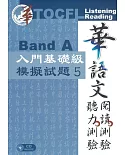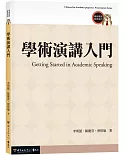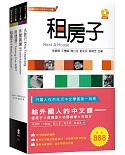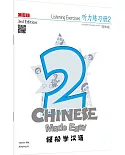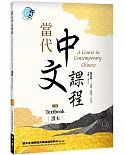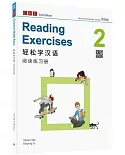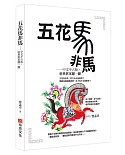‧最有效、最有趣的漢字學習法
‧一舉兩得,無論學習正體字或簡體字者,都方便使用
‧系統式建構漢字學習基礎,輕鬆記憶大量漢字
‧何謂「漢字鍵接圖像」?
「漢字鍵接圖像」(Chinese Character Key-image Pictures)是介於漢字字形和字義之間的一種圖像,讓學習者一看到圖像就能和漢字產生連結,幫助學習者快速記憶漢字。
當學習者見到漢字鍵接圖像時,就如同關鍵字記憶法一般,可同時聯想到漢字的字形及字義。這套「漢字鍵接圖像」已經獲得實驗支持,對於漢字初學者維持記憶的效果與學習興趣的提升,都優於傳統反覆記憶的學習方法。
隨著華語熱潮,國際對華語文學習的需求日益漸增,然而經過觀察,我們發現多數的華語學習者在聽和說這兩項技能掌握良好,在讀與寫的項目卻能力嚴重失衡。究其原因在於識字能力不佳。市面上有關華語文教學之教材如雨後春筍。可惜現有華語教材多強調聽和說的教學,鮮有教材針對識字能力進行重點教學。
本書由國立臺灣師範大學陳學志及林振興兩位教授共同編著,針對常用部首及漢字,基於認知學習原理,獨創了一套結合關鍵字記憶法及圖像聯想的「漢字鍵接圖像」(Chinese Character Key-image Pictures)而編寫出此套漢字教材,以協助學習者克服漢字記憶和書寫困難,奠定日後大量學習漢字的基礎。
作者介紹
作者簡介
陳學志/陈学志 Hsueh-Chih Chen
Ph.D., Psychology, National Taiwan University, Taiwan
臺灣大學心理學研究所博士/台湾大学心理学研究所博士
• Distinguished Professor of Educational Psychology and Counseling and Dean of the College of Education, National Taiwan Normal University.
• Dean to the Extension School of Continuing Education, National Taiwan Normal University.
• Co-principal Investigator of the program “The Competence-Oriented Omniform Learning Chinese as a Foreign Language (COOL Chinese)”
• Principal Investigator of the program “The Development of Whole Words and Characters Mandarin Learning Method and Digital Learning System”
• Principal Investigator of the project “The Establishment, Extension, and Application of the Chinese Orthographic and Error-type Databases.”
‧臺灣師範大學教育心理與輔導學系特聘教授兼教育學院院長
‧臺灣師範大學進修推廣學院院長
‧能力導向之全方位華語學習整合計畫共同主持人
‧華語文全字教學模式與數位學習系統之發展計畫主持人
‧漢語組字規則資料庫暨漢字偏誤資料庫建置、擴充及運用計畫主持人
• 台湾师范大学教育心理与辅导学系特聘教授兼教育学院院长
• 台湾师范大学华语文与科技研究中心主任
• 台湾师范大学进修推广学院院长
• 能力导向之全方位华语学习整合计划共同主持人
• 华语文全字教学模式与数字学习系统之发展计划主持人
• 汉语组字规则数据库暨汉字偏误数据库建置、扩充及运用计划主持人
林振興/林振兴 Zhen-Xing Lin
Ph.D., Chinese Literature, Chinese Culture University, Taiwan
文化大學中國文學研究所博士/文化大学中国文学研究所博士
• Associate Professor of the Department of Chinese as a Second Language and Associate Dean of NTNU Extension, School of Continuing Education, National Taiwan Normal University.
• Principal Investigator of the project “Developing a Computerized Chinese Proficiency Test Based on CEFR”.
‧臺灣師範大學華語文教學系副教授兼進修推廣學院副院長
‧以CEFR為基礎之數位華語教材、評量系統建置及學習載具之研發:數位華語文題庫計畫主持人
•台湾师范大学华语文教学系副教授兼进修推广学院副院长
•以CEFR 为基础之数字华语教材、评量系统建置及学习载具之研发:数字华语文题库计划主持人
陳學志/陈学志 Hsueh-Chih Chen
Ph.D., Psychology, National Taiwan University, Taiwan
臺灣大學心理學研究所博士/台湾大学心理学研究所博士
• Distinguished Professor of Educational Psychology and Counseling and Dean of the College of Education, National Taiwan Normal University.
• Dean to the Extension School of Continuing Education, National Taiwan Normal University.
• Co-principal Investigator of the program “The Competence-Oriented Omniform Learning Chinese as a Foreign Language (COOL Chinese)”
• Principal Investigator of the program “The Development of Whole Words and Characters Mandarin Learning Method and Digital Learning System”
• Principal Investigator of the project “The Establishment, Extension, and Application of the Chinese Orthographic and Error-type Databases.”
‧臺灣師範大學教育心理與輔導學系特聘教授兼教育學院院長
‧臺灣師範大學進修推廣學院院長
‧能力導向之全方位華語學習整合計畫共同主持人
‧華語文全字教學模式與數位學習系統之發展計畫主持人
‧漢語組字規則資料庫暨漢字偏誤資料庫建置、擴充及運用計畫主持人
• 台湾师范大学教育心理与辅导学系特聘教授兼教育学院院长
• 台湾师范大学华语文与科技研究中心主任
• 台湾师范大学进修推广学院院长
• 能力导向之全方位华语学习整合计划共同主持人
• 华语文全字教学模式与数字学习系统之发展计划主持人
• 汉语组字规则数据库暨汉字偏误数据库建置、扩充及运用计划主持人
林振興/林振兴 Zhen-Xing Lin
Ph.D., Chinese Literature, Chinese Culture University, Taiwan
文化大學中國文學研究所博士/文化大学中国文学研究所博士
• Associate Professor of the Department of Chinese as a Second Language and Associate Dean of NTNU Extension, School of Continuing Education, National Taiwan Normal University.
• Principal Investigator of the project “Developing a Computerized Chinese Proficiency Test Based on CEFR”.
‧臺灣師範大學華語文教學系副教授兼進修推廣學院副院長
‧以CEFR為基礎之數位華語教材、評量系統建置及學習載具之研發:數位華語文題庫計畫主持人
•台湾师范大学华语文教学系副教授兼进修推广学院副院长
•以CEFR 为基础之数字华语教材、评量系统建置及学习载具之研发:数字华语文题库计划主持人
目錄
Recommend推薦序/推荐序
Introduction編輯理念/编辑理念
How to Use This Book教材使用說明/教材使用说明
About the Authors作者簡介/作者简介
Chapter 1
Knowledge About Chinese Characters 漢字知識/汉字知识
The Eight Principles of “永” 永字八法
Structure of Chinese Characters漢字結構關係/汉字结构关系
Chapter 2
Chinese Character by Key-image Pictures 漢字鍵接圖/汉字键接图
Lesson 1 Sequence of Numbers數字次序/数字次序
Lesson 2 Flora and Fauna動植物/动植物
Lesson 3 Nature自然
Lesson 4 The Body身體/身体
Lesson 5 Pronouns and People, Professions 人稱關係與職業/人称关系与职业
Lesson 6 Artifacts人造物
Chapter 3
Review 總複習/总复习
Combination of rare component 罕見部件組合/罕见部件组合
Similar Derivative words 形似衍生字
Chinese Character Puzzles漢字拼圖/汉字拼图
Exercises綜合練習/综合练习
Answers全書解答/全书解答
Index附錄/附录
Introduction編輯理念/编辑理念
How to Use This Book教材使用說明/教材使用说明
About the Authors作者簡介/作者简介
Chapter 1
Knowledge About Chinese Characters 漢字知識/汉字知识
The Eight Principles of “永” 永字八法
Structure of Chinese Characters漢字結構關係/汉字结构关系
Chapter 2
Chinese Character by Key-image Pictures 漢字鍵接圖/汉字键接图
Lesson 1 Sequence of Numbers數字次序/数字次序
Lesson 2 Flora and Fauna動植物/动植物
Lesson 3 Nature自然
Lesson 4 The Body身體/身体
Lesson 5 Pronouns and People, Professions 人稱關係與職業/人称关系与职业
Lesson 6 Artifacts人造物
Chapter 3
Review 總複習/总复习
Combination of rare component 罕見部件組合/罕见部件组合
Similar Derivative words 形似衍生字
Chinese Character Puzzles漢字拼圖/汉字拼图
Exercises綜合練習/综合练习
Answers全書解答/全书解答
Index附錄/附录
序
Recommended 1
Learning Chinese Characters with Drawings was jointly compiled by Professor of Educational Psychology Hsueh-Chih Chen and Professor of Chinese Language Teaching Zhen-Xing Lin. ProfessorChen holds the post of Dean to the College of Education, National Taiwan Normal University. Professor Lin holds the post of Associate Professor of the Department of Chinese as a Second Language, National Taiwan Normal University. This joint work was compiled in order to assist Chinese language learners in character recognition and Chinese character writing. The book features the new revolutionary “Chinese character Key-image pictures” learning strategy, which is unique in that one and the same picture helps students to memorize both the character shape and its meaning, and unlike traditional Chinese learning textbooks, its efficiency has been proved by research. We believe that looking through Learning Chinese Characters with Drawings, learners will be fascinated by interesting and full of humor pictures, as well as creative explanations, that will surely leave a long lasting impression. Therefore, we believe learners of Chinese language will find this textbook not only interesting and engaging, but also highly effective.
Former President of National Taiwan Normal University
張國恩
Vice-President and Dean of Higher Education Sprout Project
office National Taiwan Normal University
宋曜廷
推薦序一
《我也繪漢字》乃是由本校陳學志教授與林振興教授兩位教育心理及華語文教學專家共同編撰。陳學志教授為本校「教育學院」院長;林振興教授則是本校「華語文教學系」的副教授。兩位的合作是為了解決華語文學習上漢字的辨認與書寫之難題。他們研發出「鍵接圖」(Chinese character Key-image pictures)記憶策略,其特點在於運用一個圖像可同時引發學習者聯想漢字的字形與字義,突破傳統教材設計方法,且經過實證研究發現其效果勝於傳統學習方法。翻閱《我也繪漢字》,看著饒富趣味啟發想像的圖像,充滿創意的文字解說,不禁感到興致昂然印象深刻。因此我們相信本教材必能激發華語文學習者的高度興趣,並且倍增學習效率。
國立臺灣師範大學 前校長 張國恩
國立臺灣師範大學 副校長兼高等教育深耕計畫辦公室執行長 宋曜廷
推荐序一
《我也绘汉字》乃是由本校陈学志教授与林振兴教授两位教育心理及华语文教学专家共同编撰。陈学志教授为本校「教育学院」院长;林振兴教授则是本校「华语文教学系」的副教授。两位的合作是为了解决华语文学习上汉字的辨认与书写之难题。他们研发出「键接图」(Chinese character Key-image pictures)记忆策略,其特点在于运用一个图像可同时引发学习者联想汉字的字形与字义,突破传统教材设计方法, 且经过实证研究发现其效果胜于传统学习方法。翻阅《我也绘汉字》,看着饶富趣味启发想象的图像,充满创意的文字解说,不禁感到兴致昂然印象深刻。因此我们相信本教材必能激发华语文学习者的高度兴趣,并且倍增学习效率。
国立台湾师范大学 前校长 张国恩
国立台湾师范大学 副校长兼高等教育深耕计划办公室执行长 宋曜廷
Recommended 2
The structure of Chinese characters has been studied and analyzed since ancient times, for example according to Chinese dictionary from two-thousand years ago Shuowen Jiezi (Explaining and Analyzing Characters), the character “休” is described as “person (亻) leans on tree (木)”, thus explaining its “stop to rest” meaning. On the contrary, when Shuowen Jiezi explains the character “止”, it says “Base. Grasses and trees have roots. Ancestors used stop to mean foot.” Not so easy to understand, right? As times change, so does the language. Modern language education does not need to rigidly adhere to the teaching methods of the past generations, for it is only when new knowledge is referenced to the things that students come into contact in their life, that meaningful communication becomes possible. Bearing this in mind, Professor Chen Hsueh-chih with his team of colleagues in education and technology fields, jointly wrote two Chinese language textbooks. The first one is called Learning Chinese Characters with Drawings and is focused on character structure, using association method to assist students in memorizing character structure and meaning, at the same time expanding from characters to words, making character study a practical part of learning the Chinese language. The second book is called Chinese Characters: Building Blocks, and just like building a house with building blocks, it leads learners from characters to words, and from words to complete usable sentences, as a result, proving wrong the misconception that characters and vocabulary should be taught separately.
The 23th Academician, Academia Sinica Chair Professor,
Graduate Institute of Teaching Chinese as a Second Language, National Taiwan Normal University
鄭錦全
推薦序二
漢字構形自古就有分解,例如「休」字,兩千年前的《說文解字》分析為「从人依木」,人依靠著樹木是息止的意思。但是「止」字,《說文解字》說是「下基也,象艸木出有趾。故以止為足。」那就難懂了。時有古今,言有情境。現代文字教學不必拘泥於前賢的解說,以學習者接觸的事物來論述,才能言而有物。陳學志教授領導具有教育和科技涵養的同仁,共同撰寫了兩套漢語教材,一套是《我也繪漢字》,以字形分析,建立筆形聯想來輔助字形和字義記憶,同時從漢字擴展到詞語,讓漢字實用於語言學習。第二套是《漢字積木—字本位學習法》,從文字結構分析和詞語組合再擴展到完整句子的使用,以積木的手法教學生學好語言,破除了語言學習不應受漢字干擾的迷思。
第二十三屆中央研究院院士
國立臺灣師範大學華語文教學研究所 講座教授
鄭錦全
推荐序二
汉字构形自古就有分解,例如「休」字,两千年前的《说文解字》分析为「从人依木」,人依靠着树木是息止的意思。但是「止」字,《说文解字》说是「下基也,象艸木出有趾。故以止为足。」那就难懂了。时有古今,言有情境。现代文字教学不必拘泥于前贤的解说,以学习者接触的事物来论述,才能言而有物。陈学志教授领导具有教育和科技涵养的同仁,共同撰写了两套汉语教材, 一套是《我也绘汉字》,以字形分析,建立笔形联想来辅助字形和字义记忆, 同时从汉字扩展到词语,让汉字实用于语言学习。第二套是《汉字积木—字本位学习法》,从文字结构分析和词语组合再扩展到完整句子的使用,以积木的手法教学生学好语言,破除了语言学习不应受汉字干扰的迷思。
第二十三届中央研究院院士
国立台湾师范大学华语文教学研究所 讲座教授
郑锦全
Learning Chinese Characters with Drawings was jointly compiled by Professor of Educational Psychology Hsueh-Chih Chen and Professor of Chinese Language Teaching Zhen-Xing Lin. ProfessorChen holds the post of Dean to the College of Education, National Taiwan Normal University. Professor Lin holds the post of Associate Professor of the Department of Chinese as a Second Language, National Taiwan Normal University. This joint work was compiled in order to assist Chinese language learners in character recognition and Chinese character writing. The book features the new revolutionary “Chinese character Key-image pictures” learning strategy, which is unique in that one and the same picture helps students to memorize both the character shape and its meaning, and unlike traditional Chinese learning textbooks, its efficiency has been proved by research. We believe that looking through Learning Chinese Characters with Drawings, learners will be fascinated by interesting and full of humor pictures, as well as creative explanations, that will surely leave a long lasting impression. Therefore, we believe learners of Chinese language will find this textbook not only interesting and engaging, but also highly effective.
Former President of National Taiwan Normal University
張國恩
Vice-President and Dean of Higher Education Sprout Project
office National Taiwan Normal University
宋曜廷
推薦序一
《我也繪漢字》乃是由本校陳學志教授與林振興教授兩位教育心理及華語文教學專家共同編撰。陳學志教授為本校「教育學院」院長;林振興教授則是本校「華語文教學系」的副教授。兩位的合作是為了解決華語文學習上漢字的辨認與書寫之難題。他們研發出「鍵接圖」(Chinese character Key-image pictures)記憶策略,其特點在於運用一個圖像可同時引發學習者聯想漢字的字形與字義,突破傳統教材設計方法,且經過實證研究發現其效果勝於傳統學習方法。翻閱《我也繪漢字》,看著饒富趣味啟發想像的圖像,充滿創意的文字解說,不禁感到興致昂然印象深刻。因此我們相信本教材必能激發華語文學習者的高度興趣,並且倍增學習效率。
國立臺灣師範大學 前校長 張國恩
國立臺灣師範大學 副校長兼高等教育深耕計畫辦公室執行長 宋曜廷
推荐序一
《我也绘汉字》乃是由本校陈学志教授与林振兴教授两位教育心理及华语文教学专家共同编撰。陈学志教授为本校「教育学院」院长;林振兴教授则是本校「华语文教学系」的副教授。两位的合作是为了解决华语文学习上汉字的辨认与书写之难题。他们研发出「键接图」(Chinese character Key-image pictures)记忆策略,其特点在于运用一个图像可同时引发学习者联想汉字的字形与字义,突破传统教材设计方法, 且经过实证研究发现其效果胜于传统学习方法。翻阅《我也绘汉字》,看着饶富趣味启发想象的图像,充满创意的文字解说,不禁感到兴致昂然印象深刻。因此我们相信本教材必能激发华语文学习者的高度兴趣,并且倍增学习效率。
国立台湾师范大学 前校长 张国恩
国立台湾师范大学 副校长兼高等教育深耕计划办公室执行长 宋曜廷
Recommended 2
The structure of Chinese characters has been studied and analyzed since ancient times, for example according to Chinese dictionary from two-thousand years ago Shuowen Jiezi (Explaining and Analyzing Characters), the character “休” is described as “person (亻) leans on tree (木)”, thus explaining its “stop to rest” meaning. On the contrary, when Shuowen Jiezi explains the character “止”, it says “Base. Grasses and trees have roots. Ancestors used stop to mean foot.” Not so easy to understand, right? As times change, so does the language. Modern language education does not need to rigidly adhere to the teaching methods of the past generations, for it is only when new knowledge is referenced to the things that students come into contact in their life, that meaningful communication becomes possible. Bearing this in mind, Professor Chen Hsueh-chih with his team of colleagues in education and technology fields, jointly wrote two Chinese language textbooks. The first one is called Learning Chinese Characters with Drawings and is focused on character structure, using association method to assist students in memorizing character structure and meaning, at the same time expanding from characters to words, making character study a practical part of learning the Chinese language. The second book is called Chinese Characters: Building Blocks, and just like building a house with building blocks, it leads learners from characters to words, and from words to complete usable sentences, as a result, proving wrong the misconception that characters and vocabulary should be taught separately.
The 23th Academician, Academia Sinica Chair Professor,
Graduate Institute of Teaching Chinese as a Second Language, National Taiwan Normal University
鄭錦全
推薦序二
漢字構形自古就有分解,例如「休」字,兩千年前的《說文解字》分析為「从人依木」,人依靠著樹木是息止的意思。但是「止」字,《說文解字》說是「下基也,象艸木出有趾。故以止為足。」那就難懂了。時有古今,言有情境。現代文字教學不必拘泥於前賢的解說,以學習者接觸的事物來論述,才能言而有物。陳學志教授領導具有教育和科技涵養的同仁,共同撰寫了兩套漢語教材,一套是《我也繪漢字》,以字形分析,建立筆形聯想來輔助字形和字義記憶,同時從漢字擴展到詞語,讓漢字實用於語言學習。第二套是《漢字積木—字本位學習法》,從文字結構分析和詞語組合再擴展到完整句子的使用,以積木的手法教學生學好語言,破除了語言學習不應受漢字干擾的迷思。
第二十三屆中央研究院院士
國立臺灣師範大學華語文教學研究所 講座教授
鄭錦全
推荐序二
汉字构形自古就有分解,例如「休」字,两千年前的《说文解字》分析为「从人依木」,人依靠着树木是息止的意思。但是「止」字,《说文解字》说是「下基也,象艸木出有趾。故以止为足。」那就难懂了。时有古今,言有情境。现代文字教学不必拘泥于前贤的解说,以学习者接触的事物来论述,才能言而有物。陈学志教授领导具有教育和科技涵养的同仁,共同撰写了两套汉语教材, 一套是《我也绘汉字》,以字形分析,建立笔形联想来辅助字形和字义记忆, 同时从汉字扩展到词语,让汉字实用于语言学习。第二套是《汉字积木—字本位学习法》,从文字结构分析和词语组合再扩展到完整句子的使用,以积木的手法教学生学好语言,破除了语言学习不应受汉字干扰的迷思。
第二十三届中央研究院院士
国立台湾师范大学华语文教学研究所 讲座教授
郑锦全
網路書店
類別
折扣
價格
-
新書79折$222
-
新書9折$252
-
新書9折$252
-
新書95折$266
-
新書95折$266
-
新書$540

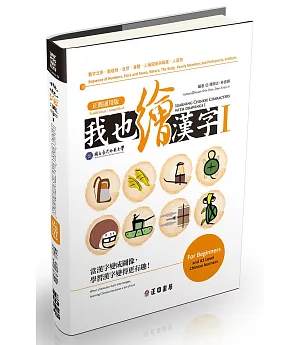


















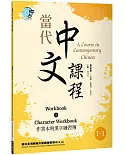

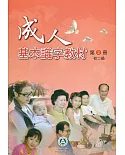
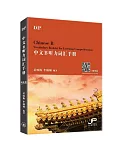

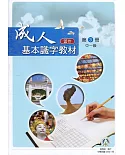
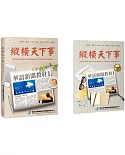
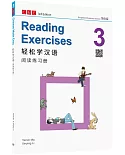
![狀元字音字形全攻略:高手過招60回[新修版]](https://www.books.com.tw/image/getImage?i=https%3A%2F%2Fwww.books.com.tw%2Fimg%2F001%2F088%2F41%2F0010884199.jpg&width=125&height=155)
